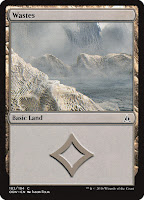Magic cards currently come in four rarities: common, uncommon, rare, and mythic rare (often shortened to 'mythic'). This post explores concepts related to rarity.
Initially, Magic had only three rarities (common/uncommon/rare). Once they began their 15-card pack structure, you'd get 11 commons, 3 uncommons, and 1 rare in a pack. When they added mythic rare (in 2008), every 8th or 9th pack would contain a mythic instead of the rare. Fun.
As you'd expect, rare and mythic cards tend to be more powerful. And since they're scarcer, they're also more expensive- though not always. Some of the most valuable cards in a set can easily end up being rares (or even uncommons); it all comes down to which cards are seeing play in tournament-winning decks.
At first, Magic didn't list rarity on the card. In fact, the idea was for players to have no idea! The designers thought it would be fun for players to encounter cards they had never seen before when they played different opponents, and that included being familiar with which cards were rares/etc. Of course, the Internet changed that in a hurry. Players could easily research every card in a set, and would quickly learn which cards were the rares.
Wizards eventually made it easy and started printing the rarity on the card. They do this two ways:
Now, some cards from Theros Beyond Death. Same deal here, except that the expansion symbol is black for the common; the others remain the same as above.
So in general, commons will have expansion symbols that are white or black, uncommons silver, rares gold, and mythics orange.
It's interesting to look at what percentage of rarities a given set contains, and how the percentages have changed over time. Wikipedia provides the data for each set. I ported the numbers into a spreadsheet, subtracted the basic lands, and produced charts for the core sets and expansions:
For the core sets, initially there were more rares in a set (41% of the cards) than anything. Then, there were equal numbers (33%) of all rarities until mythics were introduced and the percentages settled into their current forms: roughly 42% common, 29% uncommon, 22% rare, and 7% mythic in a given set. The expansions vary more widely, but have in recent years exhibited a similar breakdown.
In a future post, I'll look at ways to collect playsets (4 copies) of cards, and the rarity breakdown will be useful in relevant calculations. Stay tuned!
Initially, Magic had only three rarities (common/uncommon/rare). Once they began their 15-card pack structure, you'd get 11 commons, 3 uncommons, and 1 rare in a pack. When they added mythic rare (in 2008), every 8th or 9th pack would contain a mythic instead of the rare. Fun.
As you'd expect, rare and mythic cards tend to be more powerful. And since they're scarcer, they're also more expensive- though not always. Some of the most valuable cards in a set can easily end up being rares (or even uncommons); it all comes down to which cards are seeing play in tournament-winning decks.
At first, Magic didn't list rarity on the card. In fact, the idea was for players to have no idea! The designers thought it would be fun for players to encounter cards they had never seen before when they played different opponents, and that included being familiar with which cards were rares/etc. Of course, the Internet changed that in a hurry. Players could easily research every card in a set, and would quickly learn which cards were the rares.
Wizards eventually made it easy and started printing the rarity on the card. They do this two ways:
- The color of the expansion symbol (from 1998)
- A letter in the lower left corner (from 2014)
Now, some cards from Theros Beyond Death. Same deal here, except that the expansion symbol is black for the common; the others remain the same as above.
So in general, commons will have expansion symbols that are white or black, uncommons silver, rares gold, and mythics orange.
It's interesting to look at what percentage of rarities a given set contains, and how the percentages have changed over time. Wikipedia provides the data for each set. I ported the numbers into a spreadsheet, subtracted the basic lands, and produced charts for the core sets and expansions:
For the core sets, initially there were more rares in a set (41% of the cards) than anything. Then, there were equal numbers (33%) of all rarities until mythics were introduced and the percentages settled into their current forms: roughly 42% common, 29% uncommon, 22% rare, and 7% mythic in a given set. The expansions vary more widely, but have in recent years exhibited a similar breakdown.
In a future post, I'll look at ways to collect playsets (4 copies) of cards, and the rarity breakdown will be useful in relevant calculations. Stay tuned!










































